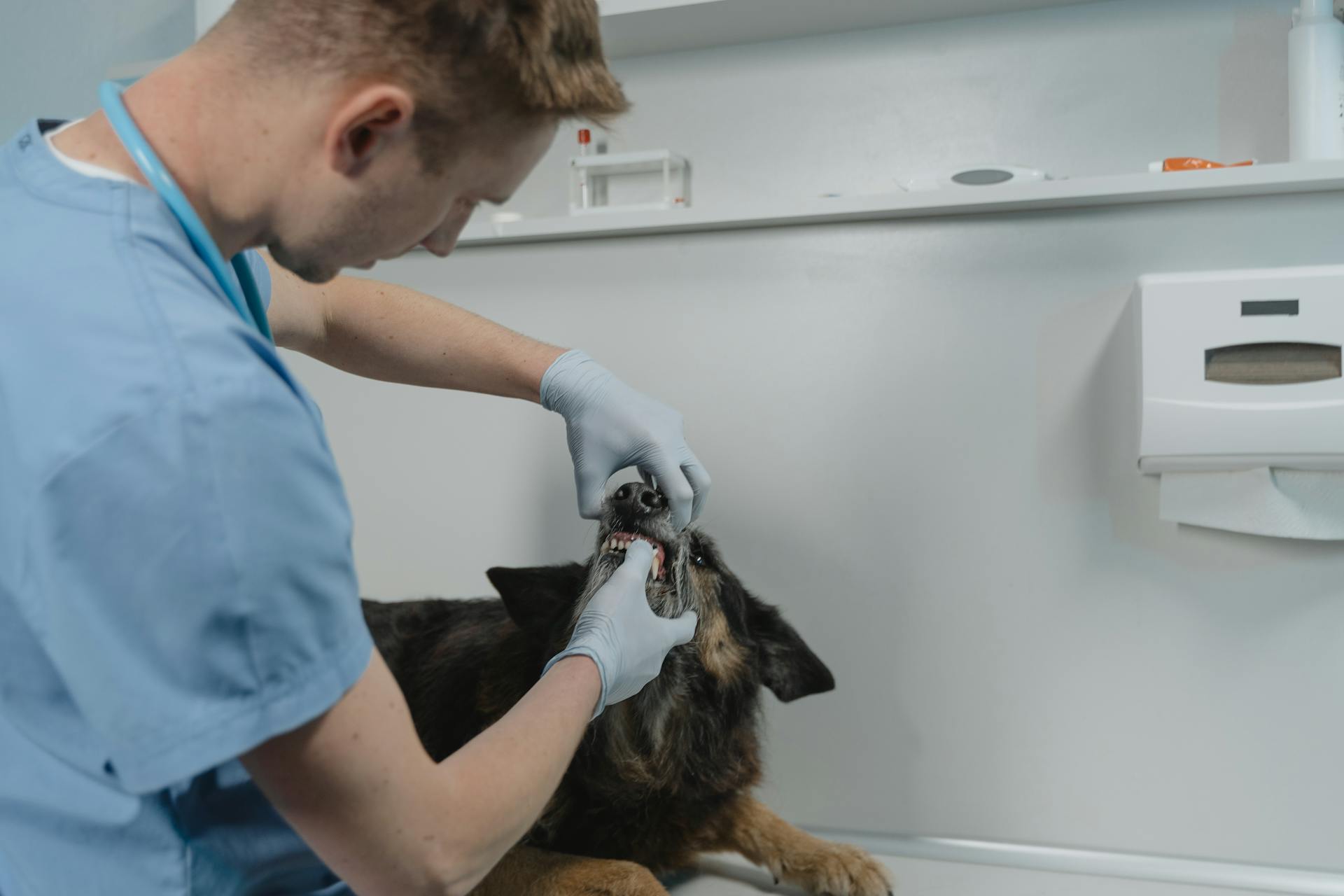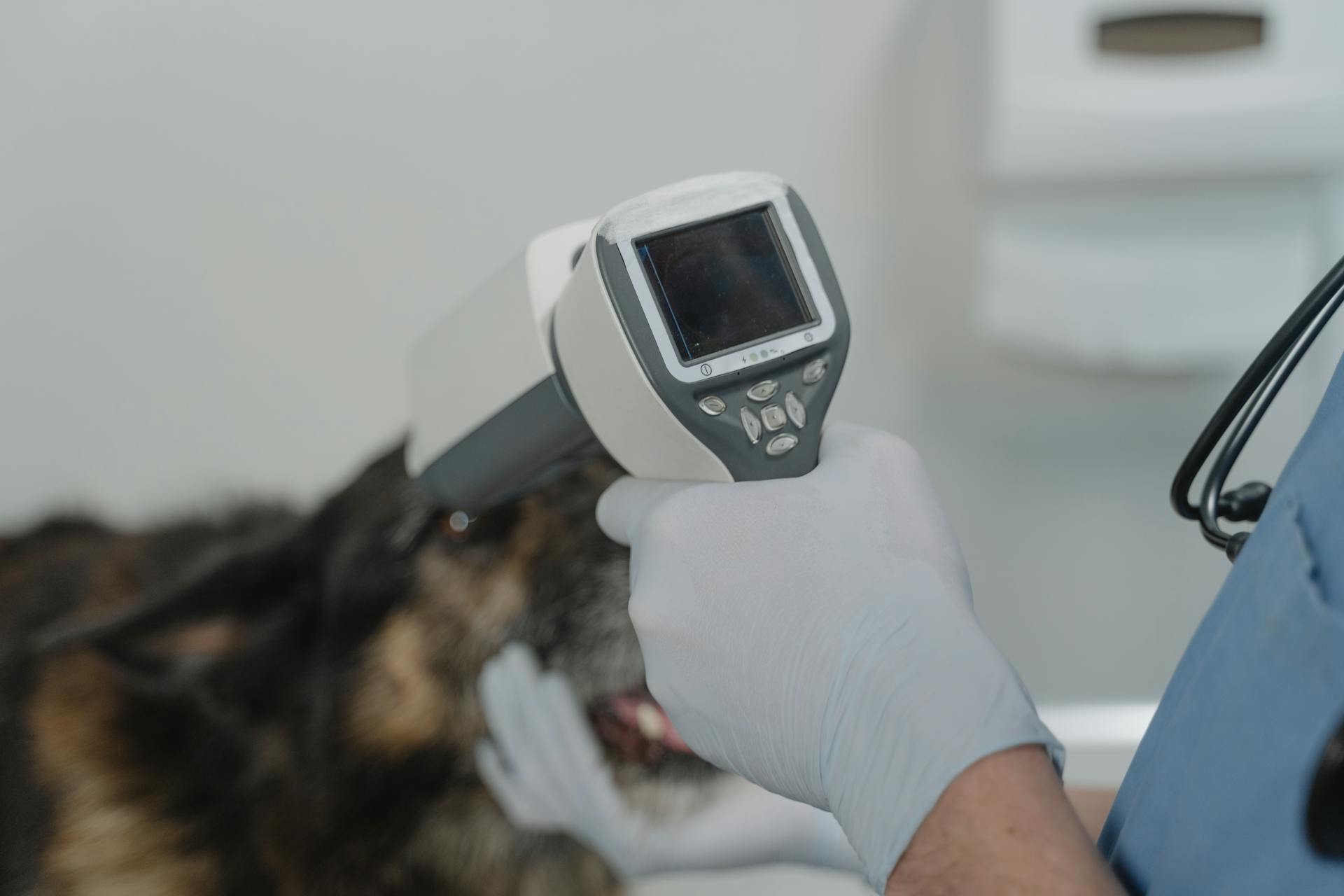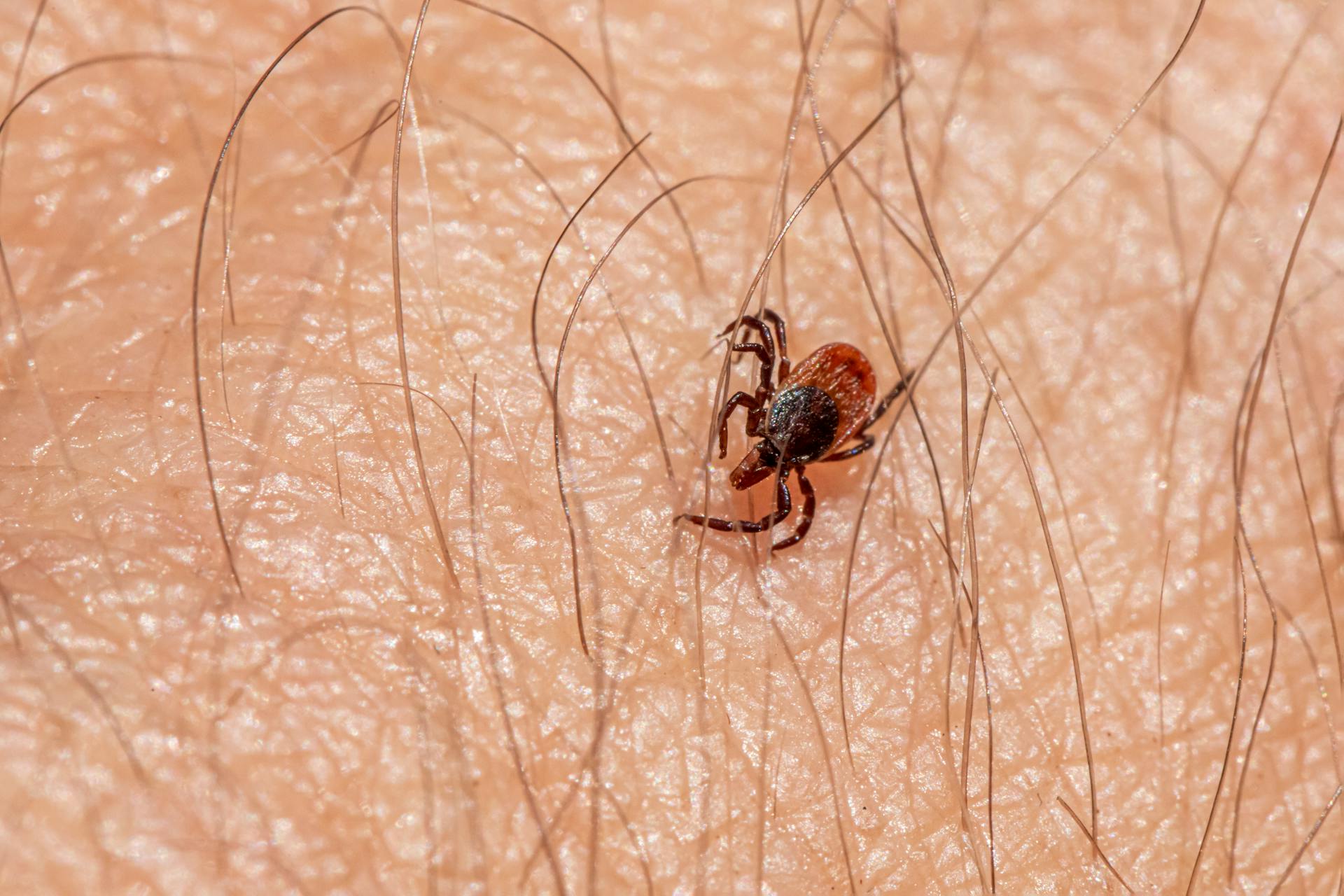
Dog tick medicine is a crucial tool in preventing infestations, and understanding how it works can give you peace of mind when it comes to your furry friend's health.
The active ingredients in dog tick medicine, such as fipronil and imidacloprid, work by targeting the nervous system of ticks, ultimately killing them.
These ingredients are typically applied topically to the dog's skin, where they are absorbed into the bloodstream and distributed throughout the body.
By killing ticks that attach to your dog, these medicines prevent the transmission of diseases like Lyme disease and Rocky Mountain spotted fever.
Tick medicine can be administered in various forms, including topical treatments, oral medications, and shampoos, each with its own unique benefits and drawbacks.
Related reading: How to Keep Ticks off a Dog?
Why Is Tick Prevention Important for Pets?
Ticks are most commonly found in the eastern United States and the West Coast, although they can be found throughout the country.
Ticks are hardy creatures that can harm our pets from their bites alone, and their bites can also contain harmful bacteria that can cause serious disease in our pets.
The symptoms of tick-borne diseases can vary greatly, but the most common symptoms include fever, swollen lymph nodes, joint pain or swelling, lethargy, and changes in the blood.
Some common tick-borne diseases include Rocky Mountain Spotted Fever in Dogs, Lyme Disease in Dogs and Cats, Ehrlichiosis in Dogs and Cats, and Babesiosis in Dogs and Cats.
Here are some examples of tick-borne diseases in pets:
- Rocky Mountain Spotted Fever in Dogs
- Lyme Disease in Dogs and Cats
- Ehrlichiosis in Dogs and Cats
- Babesiosis in Dogs and Cats
Ticks can also transmit disease to humans through tick bites, making it essential to keep ticks out of the home through proper tick preventatives.
How Tick Medications Work
Tick medications work by disrupting the nervous system of the tick, eventually killing it. This prevents the tick from completing its blood meal and reduces the risk of disease transmission.
Flea and tick preventatives often require a prescription from a vet to ensure the right medication and dosage. Some over-the-counter products work well, but it's essential to inform your pet's providers about any treatments used.
Fipronil/S-methoprene is a common ingredient in over-the-counter flea and tick preventions. Fipronil kills insects by disrupting their nervous systems.
Isoxazoline is a highly effective prescription preventative that can remove ticks within 4-24 hours. It works by inhibiting a neurotransmitter called GABA, leading to paralysis and death.
Afoxolaner is a powerful active ingredient found in Nexgard, which selectively binds to GABA-gated and glutamate-gated chloride channels in insect and acarine nerve cell membranes. This results in hyperexcitation and death of the flea or tick.
Nexgard and NexGard SPECTRA provide long-term flea and tick prevention for 35 days, protecting against paralysis ticks, brown dog ticks, and bush ticks.
Types of Tick Medications
Tick medications come in various forms, each with its own unique way of working. Oral medications, such as Bravecto and Nexgard Spectra, work by entering the dog's system and becoming active in the tissue, bloodstream, and skin.
Oral medications are only available for dogs at this stage, and they work by being ingested by the flea or tick, ultimately leading to their death. Topical medications, on the other hand, are applied directly to the skin and work by absorbing into the bloodstream or spreading via the hair and skin's natural body oils.
Some topicals work by targeting the nervous system of the flea or tick, killing them through paralysis and death. Common ingredients of topicals include insect neurotoxins, such as fipronil, (S)-methoprene, imidacloprid, permethrin, and pyriproxyfen.
Check this out: Dog Skin Odor
Flea & Tick Medications
Flea & Tick Medications work by disrupting the nervous system of the tick and eventually killing it, preventing the tick from completing its blood meal. This can be achieved through various active ingredients, such as Fipronil, Isoxazoline, and Dinotefuran.
Fipronil, a common ingredient in over-the-counter flea and tick preventions, kills insects by disrupting the function of their nervous systems. Isoxazoline, a newer and highly effective prescription preventative, works by inhibiting a neurotransmitter called GABA, leading to paralysis and death.
Oral flea and tick medications, such as Bravecto and Nexgard Spectra, are available for dogs and work by entering the dog's system and becoming active in the tissue, bloodstream, and skin. Topical flea and tick medications, such as Bravecto Spot on, are applied directly to the skin and work similarly to oral chews.
Some topical flea preventatives work by spreading via the hair and the skin's natural body oils, killing fleas that come into contact with the pet's coat. Others work by absorbing through the skin and circulating into the bloodstream, killing fleas when they bite the pet.
Related reading: Dog Skin Health
The length of treatment between medications can vary, with some lasting for 3 months, while others last for 6 months. It's essential to follow the correct dosing schedule to keep your pet protected at all times.
Here's a breakdown of some common flea and tick medications and their active ingredients:
These medications can be safely used with other medications, including antibiotics, and are available in various forms, such as chews, spot-ons, and sprays. It's essential to consult with a veterinarian to determine the best flea and tick prevention for your pet based on their individual needs and health status.
Ingredient: Deltamethrin
Deltamethrin is a common ingredient in tick medications. It's found in products like ShieldTec Flea & Tick Collar.
This ingredient targets fleas and ticks, making it a popular choice for pet owners. It kills fleas by disrupting their nervous system function.
You can use deltamethrin-based products on pets that are 12 weeks or older. The treatment frequency is typically 6 months, so you won't need to reapply it as often.
Here's a quick rundown of the key facts about deltamethrin:
- Found in: ShieldTec Flea & Tick Collar
- Requires a prescription?: No
- Targets: Fleas and ticks
- Treatment frequency: 6 months
- Age limit: 12 weeks or older
- How it works: Kills fleas by disrupting nervous system function.
Active Ingredients

Active ingredients are the key to understanding how dog tick medicine works. Dinotefuran, pyriproxyfen, and permethrin are just a few of the many active ingredients used in flea and tick treatments.
These ingredients work together to kill fleas and ticks by overstimulating their nervous system, inhibiting key neurotransmitters, and interfering with insect growth and development. For example, dinotefuran and permethrin kill fleas by overstimulating their nervous system.
Some common active ingredients include fipronil, (S)-methoprene, and pyriproxyfen. Fipronil kills fleas by inhibiting a key neurotransmitter in the pest's central nervous system.
Here's a breakdown of some common active ingredients and their effects:
Ingredients: Etofenprox, Pyriproxyfen, (S)-Methoprene
Etofenprox is the active ingredient that kills fleas by overstimulating their nervous system.
This ingredient is found in the Adams Plus Flea & Tick Spot On product.
Pyriproxyfen and (S)-Methoprene are also active ingredients that work together to prevent flea reproduction.
These insect growth regulators interfere with insect growth and development, making it impossible for fleas to reproduce.
Here are the active ingredients found in Adams Plus Flea & Tick Spot On, along with their targets and treatment frequencies:
These active ingredients are suitable for dogs 12 weeks or older.
Ingredients: Fipronil, (S)-Methoprene, Pryproxyphen

Fipronil is a key ingredient in many flea and tick treatments. It kills fleas by inhibiting a key neurotransmitter in the pest's central nervous system.
You can find Fipronil in products like Frontline Plus, Onguard, and PetArmor Plus, all of which require no prescription. These products are designed to target both fleas and ticks.
Fipronil works in conjunction with another ingredient, (S)-Methoprene, which is an insect growth regulator. This means it interferes with insect growth and development, preventing reproduction.
Here's a breakdown of some common products that contain Fipronil and (S)-Methoprene:
Priproxyfen is another insect growth regulator that works alongside Fipronil and (S)-Methoprene. It's found in Frontline Gold Flea & Tick Treatment and helps prevent flea reproduction.
These ingredients are all safe to use on pets 8 weeks or older, and they're designed to provide long-lasting protection against fleas and ticks.
Ingredients: Permethrin, (S)-Methoprene
Permethrin is a key ingredient in some flea and tick control products, found in Zodiac Spot On Flea & Tick Control. It kills fleas by overstimulating their nervous system.
If this caught your attention, see: Dog Poison Control Phone Number

(S)-Methoprene, on the other hand, is an insect growth regulator that prevents flea reproduction. It's also found in Zodiac Spot On Flea & Tick Control.
Let's break down some key facts about these ingredients:
As you can see, Zodiac Spot On Flea & Tick Control is available over-the-counter, while Bravecto Topical requires a prescription. Both products target fleas, but have different treatment frequencies and age limits.
Frequently Asked Questions
Can dogs on tick medicine still get ticks?
Yes, dogs on tick medicine can still get ticks, but the ticks will be killed after biting and feeding on their blood. This is because oral tick medications make the pet's blood poisonous to ticks.
Will ticks fall off dogs after treatment?
Ticks may not fall off immediately after treatment, as it can take up to 24-48 hours for the treatment to be effective. Dead ticks may remain attached to your dog until they naturally fall off.
How long does it take for dog flea and tick medicine to work?
Topical flea preventions typically clear current flea burdens within 12-48 hours, while oral preventions often start working within 2-4 hours. Effective flea and tick medicine can bring quick relief to dogs.
Sources
- https://www.petmd.com/how-do-common-tick-medications-work-pets
- https://www.goodnavet.com.au/post/flea-tick-medications-how-do-they-work
- https://www.thevetshed.com.au/blog/nexgard-flea-and-tick-control-how-it-works-and-its/4268
- https://www.1800petmeds.com/education/how-do-topical-flea-preventatives-work.html
- https://be.chewy.com/dog-flea-tick-medicine-fipronil-permethrin-imidacloprid-pill-topical-oral-prevention-treatment/
Featured Images: pexels.com


